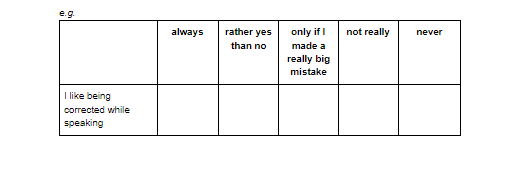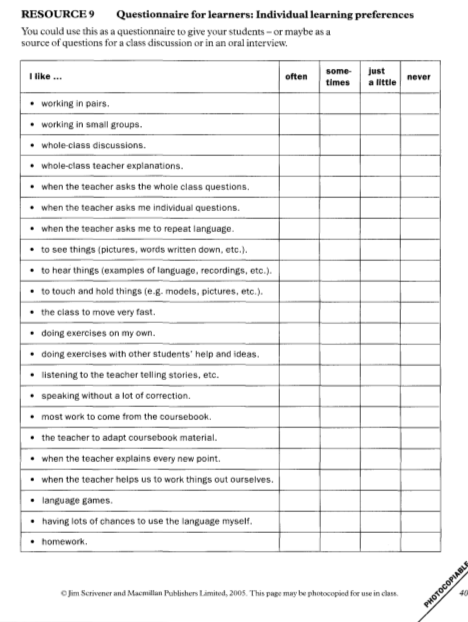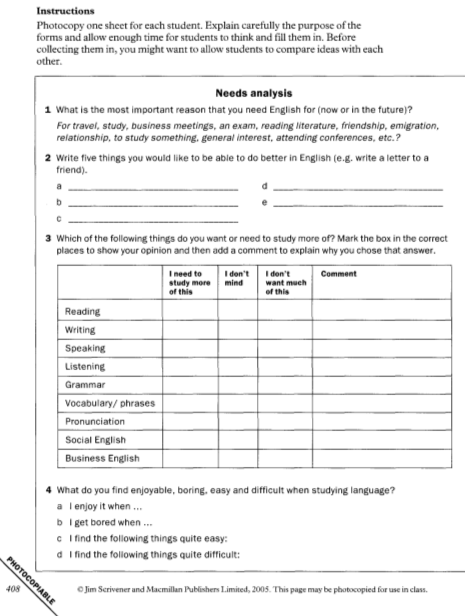Any teacher needs to analyse the needs of a student. Needs analysis is a combination of tools, procedures and materials that can be used to find out the learners’ needs. The process entails engaging in activities with the learner to uncover their learning needs: motivation for learning English, learning goals, and the learner’s preferences — ranging from traditional lessons to immersive speaking practice.
This approach positions the student at the core of the learning process, enabling teachers to create and adapt courses with this particular student in mind. This article will present some ideas of using needs analysis in teaching adults and teenagers.
How to analyse the student’s needs?
There are different ways to go about it. The most popular ones are questionnaires, interviews, observations or their combinations. The choice depends a lot on the students themselves and what would work best for them. For example, you can ask the shy ones to write a short paragraph about what they like or find challenging about learning English. Low-level students might be given questionnaires or interviewed in their mother tongue. Below, you will find some activities which will help you with collecting data:
- Filling in the questionnaire
This is the most traditional and safest way. You can use an already prepared form, or you can create something special.
- Interview
This technique works especially well with students who study one on one with the teacher. Not only will it give you the information about learner’s needs, but it will also let you assess their level. In groups, students can work in pairs interviewing each other. Check some question ideas here.
- Presentation
Ask your students to give a presentation about their goals, learning experience, and English studies.
- Writing
Let them write! Assign a topic, for instance, ‘English. My _______ story’ where students have to choose the adjective themselves. It can be done as an essay or a short paragraph, in English or in L1, in class or as part of homework.
- Observation
Do the job yourself. It’s the most time-consuming way of gathering data, but it’s totally worth it. An attentive teacher can spot tons of things, from learning style to reaction to correcting. Keep a journal and write down topics your students seem to like, interaction patterns they enjoy or their reaction to musical, physical, analytical, and other kinds of activities.
Read more:
What to include in a needs analysis questionnaire?
Reasons for learning English
Understanding true reasons will help the teacher tailor the course a bit. Unlike adult learners, teens are not likely to analyse their motivation deeply, so you can provide them with a multiple-choice question here. Some of the possible options are:
e.g. I’m learning English to
- be able to study abroad
- read and listen to things I like in English
- get an A at school
- be understood by the guys from that online game
- watch manga/series with English subtitles when it is not translated into Russian.
Previous learning experience
Finding out about your students’ previous learning experiences might also prove useful. This way you can detect activities they haven’t enjoyed or things that worked well.
e.g. What was your most memorable English lesson? Write 5–6 sentences.
Expectations from the teacher
Ask students how they see the role of a teacher. For teens, some hate being corrected while speaking, while others need long detailed feedback on their writing tasks. If you know this in advance, your cooperation with students will be much more fruitful.

Learning style
Have you noticed that even within a small group all students enjoy different kinds of activities? Some are ready to die for a song-based lesson, some just can’t sit still and keep fidgeting or touching things all the time, some enjoy contemplating. A few questions about learning styles or multiple intelligences can help you find a way to approach your learners and offer activities they will enjoy.
e.g. Tick the ideas that are true for you:
- I need to move around or stretch during the lesson.
- I focus better when it’s quiet.
- I’m not into music or singing.
- I don’t like touching objects or realia.
If you opt for a ready-made questionnaire, you can try the one designed by Jim Scrivener and published in his Learning Teaching.
A tailor-made questionnaire is a useful tool to fine-tune the course to the needs of students you’ve been teaching for some time. This way you can base the questions on something you already know about them and make the studying process even more productive.
Ready-made ones can be a real time saver at the beginning of a school year or when a new student unexpectedly shows up.
When a needs analysis has to be done?
Let’s look at the situation below — Maria is speaking with a friend about her English lessons.
Maria: You know, not bad. I am still learning a lot of things; I mean, a lot of new words. We also do many exercises to improve my grammar.
Tanya: However, you do not seem to be happy, do you?
Maria: That is right to a point. I do not understand why. The teacher is doing what I asked her to do. She is teaching me new words, she is correcting my mistakes. She explains grammar rules very well.
Tanya: Then why aren’t you happy?
Maria: I get bored, and I often force myself to go to the lesson.
Tanya: Maybe, you should talk to your teacher and ask her to change something in the lesson.
Maria: I think I will.
Later on the same day. During the lesson
Maria: Well, I would like to ask you to change something in the lesson. I think I am losing motivation.
Teacher: But this is what you told me to do. You told me to improve your vocabulary and grammar. And I am doing it.
Maria: Yes, you are right. It is not your fault. But I do not know why I am not motivated to study anymore.
Teacher: But you should remember that you need this because you want a promotion in your office. So if you want to get promoted, you should level up your English.
Maria: You are right.
What happens later
Maria no longer wants to attend her English lessons. The teacher concludes that Maria lacks a sense of responsibility and does not really need any career advancement.
What actually happens
Maria, a young and driven employee, is working hard to get a promotion. Her diligence within the company has caught the boss’s attention. However, all the efforts exhaust her. By the time she attends her English class, she does not have enough energy to study.
The teacher is a professional. As a responsible person, she does what Maria has asked her to do: she teaches her grammar and new words. Maria’s teacher back in school had instilled in her the belief that vocabulary and grammar skills are essential for English proficiency — a belief she continues to hold to this day.
What mistakes did the teacher make?
She did not truly analyse Maria’s needs. In many cases, students get trapped in their stereotypes — they think they know what and how they should study the language, but that is not the case. The real needs of every student should be analysed continuously since the students’ themselves may not even realise what they actually need.
Teachers should consistently inquire about the reasons behind students’ language studies and the contexts in which they plan to apply their language skills. There may arise instances where a student’s necessity is geared towards composing work-related emails, prompting the teacher to concentrate on practising their writing skills. If a student needs to attend meetings and make presentations to colleagues in English, a teacher might opt for concentrating on refining the student’s listening and speaking skills.
In Maria’s case, she got very tired at work; she did her work very well and with a sense of responsibility. And she got overwhelmed. When she attended her English lessons, she did not have enough emotional and mental reserves to study. She needed more fun — a more enjoyable learning experience that could still yield productive results. Unfortunately, her teacher did just the opposite. She put a lot of seriousness in her lessons, causing anxiety in Maria.
While our intent is to be productive and professional, we occasionally forget that we cannot be productive without understanding the real needs of our students. Interestingly, sometimes the students themselves do not fully understand what they need to learn the language.
Read more:
How is it different with teenagers?
Most adult students have at least some idea of why they are learning a foreign language. With teens, however, it’s not so easy to figure out. Some of them are unable to analyse their needs without proper assistance. Others just say things like, ‘My parents took me here’ or ‘I dunno, everybody’s learning that.’
Needs analysis with teens is great for building learner awareness and autonomy. It can motivate teenagers and make them start thinking about their own goals and responsibilities. What’s more, a classroom environment where every opinion is heard and taken into account will have a positive influence on group dynamics and teacher-learners relationships.
When is the best time for a need analysis?
Devoting some part of a lesson to working with needs analysis can mark the beginning of a new studying year. It is a great opportunity to learn more about a new group of students. However, teenagers you’ve known for years can also surprise you with some new ambitions.
Another option is to use bits of needs analysis throughout the whole year. It can be used to:
- plan the next lesson or month
- get students’ evaluation of the course and learning activities
- vote for the topics from the coursebook to be enlarged or excluded
- find out more about learning styles and preferences of each other
- collect the feedback about the usefulness of a lesson or some of its parts.
Teenagers don’t always have strong motivation or perseverance. And, let’s be honest, they aren’t often asked about their preferences at school. A well-designed needs analysis and some proper work with the collected data afterwards can help students be heard.
Tips that might help you to understand the needs of a student
- During the lesson, always keep an attentive eye on the signals (often unconscious) conveyed by a student, such as gestures, facial expressions, posture, and eye contact. Signals are more intuitive and genuine than words. They offer deeper insights into the student’s emotions.
- After teaching something new, ask them where and how they will use gained knowledge in their life.
- Try to understand what type of learners they are — visual, auditory, kinesthetic, analytical, etc. Each type of learner has their preferred way of learning the language. Of course, it does not mean that you are going to use only texts and images for visual learners or rely solely on listening materials for auditory learners. Nevertheless, their preferred learning style typically proves the most effective.
- Mark the activities that make the student most enthusiastic.
And remember that understanding a student’s needs isn’t just about what the student learns, but equally about how the student learns and the significant ‘why’ behind their motivation to attend lessons and get better.

















 Ольга Клементьева
Ольга Клементьева 
 Анна Тетерина
Анна Тетерина 
 Диляра Биктагирова
Диляра Биктагирова 
 Маргарита Аветисян
Маргарита Аветисян 
